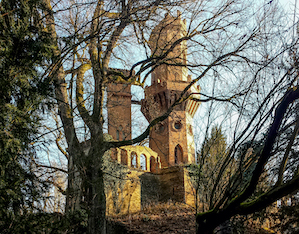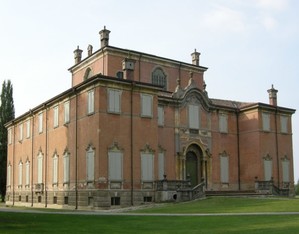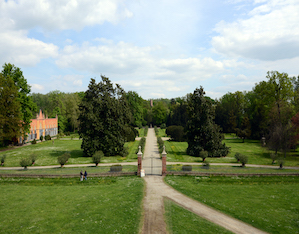This park is the most representative example of “Romantic” garden in Emilia Romagna: the coexistence of residential and functional buildings, of landscaping features and of a traditional rural environment lend unique historical, cultural and environmental value to the site.
Between the end of the 17th and the early-18th century, Count Antonio Sorra from Modena commissioned from Bolognese architect Antonio Torri the creation of a villa that would serve as a comfortable retreat “per necessario comodo di villeggiare”. The construction work was concluded by his nephew Francesco Maria who also instated a today no-longer-existent formal garden, documented by the tempera paintings now part of the Musei Civici di Modena collections and once displayed in the so-called “camera dipinta a giardino”, a garden room inside the villa. In 1827 Ippolita Levizzani, widow of Count Cristoforo Sorra initiated the transformation of the formal garden into an English landscape garden: the project was entrusted to the Director of the Botanical Gardens of Modena, Giovanni de’ Brignoli di Brünnhoff; further interventions were carried out by landscape painters Ottavio Campedelli and Tommaso Giovanardi, scenographer Camillo Crespollani and engineer Cesare Perdisa, who designed the Gothic Revival greenhouse in 1842). The park features an ample selection of landscape features as those promoted by Ercole Silva and Luigi Mabil in Italy at the time: a lake with a few islands, a fisherman’s hut, a hunter’s lodge, various water features, and a “hermitage” home to an unexpected kaffeehaus with water features, fake antique and medieval ruins, including two turrets upon a hill, castle ruins, grottoes and belvedere terrace. The oaks, magnolias, yews and box trees date back to the 19th century landscaping, but the park is also home to hazelnut trees, Judas trees, maples, ash, manna ash, hornbeams, horse chestnuts, Atlas cedars, downy oaks, elms, and different sycamore and poplar species. During the 19th century, the square before the main entrance was modified with the “cavallerizza”, a 140-meter diameter circular route with a double row of sycamore trees. After various transitions, in 1972 Villa Sorra became property of the Municipalities of Castelfranco Emilia, Modena, Nonantola and San Cesario sul Panaro.





